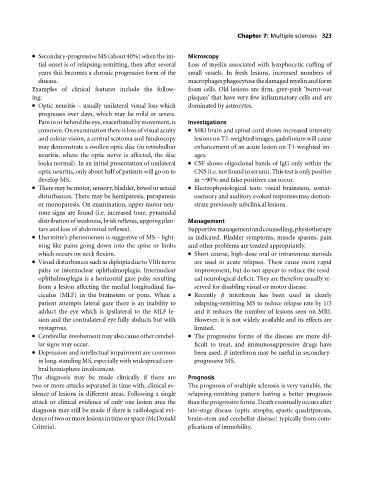Page 327 - Medicine and Surgery
P. 327
P1: FAW
BLUK007-07 BLUK007-Kendall May 25, 2005 18:18 Char Count= 0
Chapter 7: Multiple sclerosis 323
Secondary-progressive MS (about 40%) when the ini- Microscopy
tial onset is of relapsing-remitting, then after several Loss of myelin associated with lymphocytic cuffing of
years this becomes a chronic progressive form of the small vessels. In fresh lesions, increased numbers of
disease. macrophagesphagocytosethedamagedmyelinandform
Examples of clinical features include the follow- foam cells. Old lesions are firm, grey-pink ‘burnt-out
ing: plaques’ that have very few inflammatory cells and are
Optic neuritis – usually unilateral visual loss which dominated by astrocytes.
progresses over days, which may be mild or severe.
Paininorbehindtheeye,exacerbatedbymovement,is Investigations
common. On examination there is loss of visual acuity MRI brain and spinal cord shows increased intensity
and colour vision, a central scotoma and fundoscopy lesions on T2-weighted images, gadolinium will cause
may demonstrate a swollen optic disc (in retrobulbar enhancement of an acute lesion on T1-weighted im-
neuritis, where the optic nerve is affected, the disc ages.
looks normal). In an initial presentation of unilateral CSF shows oligoclonal bands of IgG only within the
optic neuritis, only about half of patients will go on to CNS(i.e.notfoundinserum).Thistestisonlypositive
develop MS. in ∼90% and false positives can occur.
There may be motor, sensory, bladder, bowel or sexual Electrophysiological tests: visual brainstem, somat-
disturbances. There may be hemiparesis, paraparesis osensory and auditory evoked responses may demon-
or monoparesis. On examination, upper motor neu- strate previously subclinical lesions.
rone signs are found (i.e. increased tone, pyramidal
distribution of weakness, brisk reflexes, upgoing plan- Management
tars and loss of abdominal reflexes). Supportivemanagementandcounselling,physiotherapy
Lhermitte’s phenomenon is suggestive of MS – light- as indicated. Bladder symptoms, muscle spasms, pain
ning like pains going down into the spine or limbs and other problems are treated appropriately.
which occurs on neck flexion. Short course, high-dose oral or intravenous steroids
Visual disturbances such as diplopia due to VIth nerve are used in acute relapses. These cause more rapid
palsy or internuclear ophthalmoplegia. Internuclear improvement, but do not appear to reduce the resid-
ophthalmoplegia is a horizontal gaze palsy resulting ual neurological deficit. They are therefore usually re-
from a lesion affecting the medial longitudinal fas- served for disabling visual or motor disease.
ciculus (MLF) in the brainstem or pons. When a Recently β interferon has been used in clearly
patient attempts lateral gaze there is an inability to relapsing-remitting MS to reduce relapse rate by 1/3
adduct the eye which is ipsilateral to the MLF le- and it reduces the number of lesions seen on MRI.
sion and the contralateral eye fully abducts but with However, it is not widely available and its effects are
nystagmus. limited.
Cerebrellar involvement may also cause other cerebel- The progressive forms of the disease are more dif-
lar signs may occur. ficult to treat, and immunosuppressive drugs have
Depression and intellectual impairment are common been used. β interferon may be useful in secondary-
in long-standing MS, especially with widespread cere- progressive MS.
bral hemisphere involvement.
The diagnosis may be made clinically if there are Prognosis
two or more attacks separated in time with, clinical ev- The prognosis of multiple sclerosis is very variable, the
idence of lesions in different areas. Following a single relapsing-remitting pattern having a better prognosis
attack or clinical evidence of only one lesion area the thantheprogressiveforms.Deatheventuallyoccursafter
diagnosis may still be made if there is radiological evi- late-stage disease (optic atrophy, spastic quadriparesis,
denceoftwoormorelesionsintimeorspace(McDonald brain-stem and cerebellar disease) typically from com-
Criteria). plications of immobility.

